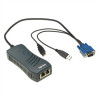Lantronix Spider KVM Lantronix Spider / SpiderDuo - User Guide - Page 54
Passthrough Use, Telnet Console Use, LOGIN, PASSWORD, Version, Connect Serial, Logout, Esc-Exit
 |
View all Lantronix Spider KVM manuals
Add to My Manuals
Save this manual to your list of manuals |
Page 54 highlights
6: Remote System Control port numbers also may be changed from their defaults. A user attempting to connect via Telnet or SSH must also have the appropriate permissions. Passthrough Use When using Telnet/SSH in passthrough mode, the Spider device just acts as a conduit for the serial data traveling between the client system and whatever is connected to the serial port. This may be a COM port on the remote computer, or a serially controlled power strip, or anything else with an RS-232 port. 1. From the client system, use a Telnet or SSH utility to connect to the IP address of the Spider device, at the assigned Telnet TCP port number. 2. The Spider device will present LOGIN and PASSWORD prompts. Enter a valid user name and password. The user must have permissions set to use Telnet or SSH. 3. The Spider device will reply with a Welcome and status, followed by a command line prompt. Selections are: Help-Displays a list of commands Version-Displays the current Spider firmware version number Connect Serial-Enter passthrough to serial port mode Logout-Terminates the Telnet or SSH connection 4. Enter connect serial to open the connection to the serial port. 5. You are now connected and may interact with the attached serial console. Keystrokes are not locally echoed and must be echoed by the connected serial device. 6. Use the SSH or Telnet ability to send and receive serial data between the client and the serial port. The Spider device does not echo this data back to the client. 7. When complete, enter Esc-Exit to return to the command line. 8. Enter logout or l to close the connection. Telnet Console Use When using the Telnet Console, the Spider device opens a window on the client system that provides direct access to the Telnet/SSH command line. This eliminates the need to have a Telnet or SSH utility running on the client system. 1. Click the Terminal button at the top of the Spider page. The user must have permissions set to use Telnet or SSH. The JRE will launch, and the Telnet Console window appears. Telnet Console and Remote KVM Console windows may be open concurrently. Spider™ and SpiderDuo® KVM-over-IP Device User Guide 54















